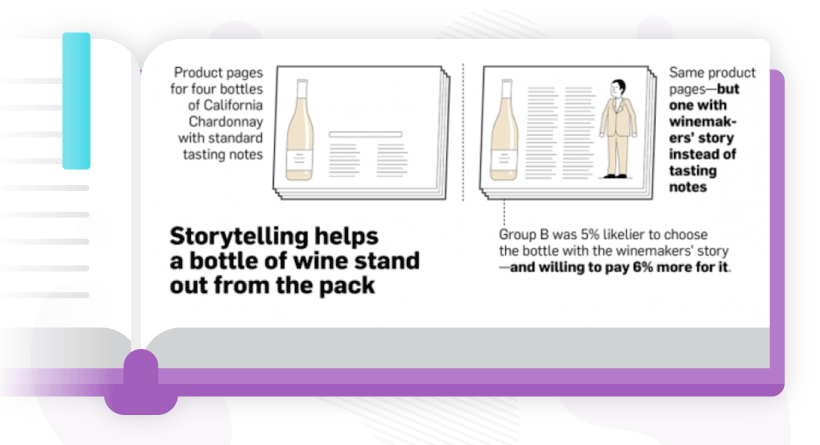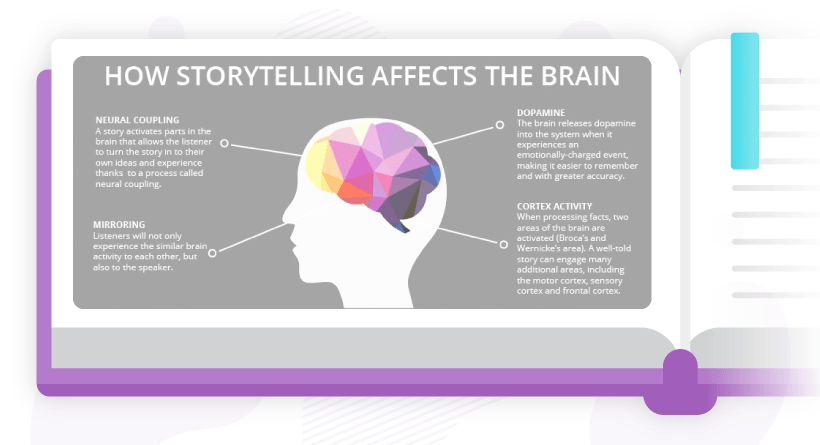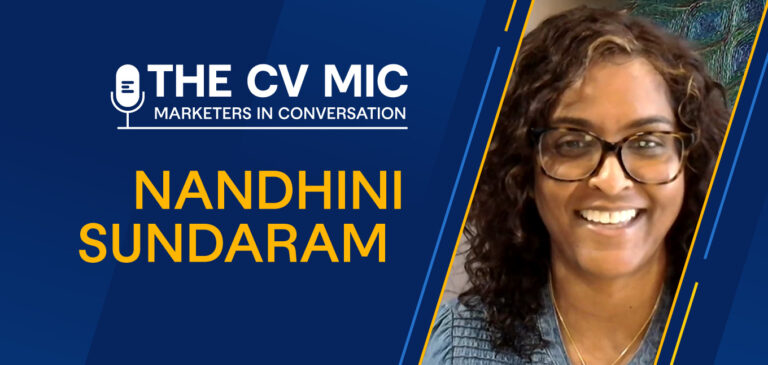Storytelling has been around as long as humans have. Hieroglyphs were used in ancient Egypt about 5,000 years ago to become one of the earliest writing systems in the world. Tens of thousands of years before that? Cavemen were doodling stories using a stick for a pen and mud for paper.
Not much has changed since… kidding, a lot has changed. But, stories haven’t — because it’s in our nature as humans to tell them. It’s also in our nature to listen to them.
In today’s noisy, techy, automated world, storytelling is not only still relevant, it’s important. Without stories we can connect with, we lose something big when humanity gets lost in technology.
In the digital age, we are more connected than ever before, yet so many of us feel disconnected. Why are we on social media every day? What are we searching for on Google? A human connection and more experiences told through stories.
We forget names and faces. We forget what we learned in high school algebra because it was high school algebra. But a good story? We don’t forget it.

Source: AdWeek
We’ve all heard so much about the power of storytelling. It gets thrown around a lot. But the real question is… Why? Why is it storytelling powerful? And, why is storytelling important for your brand?
Sure… There is an art to storytelling
Attention is a commodity, especially in today’s digitally distracted world. The goal for any story — whether that be a book, film, or piece of content — is to try and hold that attention.
That can happen through tension that makes us flip the pages faster to see what is going to happen to our protagonist when she’s running through the jungle to escape poisonous fog. It’s a scene that makes our palms sweat and our muscles tighten up — we’re completely enthralled, and we feel like we’re there running for our lives, too.
Or, our attention might be held by a sacrifice we hope we never have to make, like a young woman trading her own life for her little sister’s to take her place in a fight to the death in an arena. Along the way, there are ups and downs — a little comic relief from a drunken mentor with a knack for sarcasm to make us crack a smile, and a dash of romance from a doomed love triangle to make us feel longing and heartache.
It’s rare when a movie is just as good as a book. But in the case of the wildly successful ‘Hunger Games’ franchise, a written story on the page was brought successfully to life on the screen. Both mediums worked, appealing to a wide audience beyond the initial young adult categorization of the novel. But, why?
Whether you like ‘The Hunger Games’ or not, it’s fair to say that Suzanne Collins knew what she was doing when she wrote this story. She went after our emotions, striking with heart-wrenching precision at times while moving us along an emotional rollercoaster. By tapping into emotion through an artistic strategy, Collins hooked us and held our attention.
“Today’s availability of technology means that any business in any industry can develop an audience through consistent storytelling.” ― Joe Pulizzi
Marketers can replicate the art of storytelling by creating content that moves people. How do different types of content trigger a response? What words and imagery speak to the people you hope will listen? We can tap into pain points to create tension, and we can tap into aspirations to inspire.
Because storytelling is an art, always remember to experiment to see what clicks with your audience. You can see if it’s working in your data, by looking at engagement and audience growth.
But… There is science behind it
A story that’s missing emotion? It doesn’t work the same way. The emotional stimulation of a story unlocks empathy in our brains. Empathy is so powerful for us as humans because we are such social creatures. It allows us to assess the situation and decide where we are going to go with a relationship — if we go anywhere at all.
When we meet a stranger, we are going through this assessment based on the stories they share about themselves: who they are, what they do, what they believe in. If we connect with their story, we decide to move forward with the relationship.
Depending on the impact of their story, we may remember them well enough to meet up for coffee and deepen the relationship. Or, we may not remember them, and they become an acquaintance.
Source: OneSpot
Marketers can replicate the science of storytelling by creating content that moves people to take an action. How did your customer become your customer? Did they read some of your content along the way? Follow you on social media? Attend a webinar and subscribe to your blog? Track this, so you know what’s working. They remembered — and chose you over your competitors, because you told a better story somewhere.
Because storytelling is also a science, always remember to experiment to see what is remembered by your audience. You can see if it’s working in your data, by repeat engagement and customer growth.
Our brains are wired to remember stories
The brain chooses the information it wants, then remembers that information because of the emotional connection. Humans are both scientific and artistic beings, and we use the left brain and the right brain — so we function and respond to both when it comes to storytelling. And since it has the power to change us in such a way, we simply don’t forget a great story.
In ClearVoice’s recent storytelling interview with best-selling author Kristen Lamb, she discussed how our brains are wired to remember stories. For example, if you decide one day that you’re going to buy a red Honda, what do you see everywhere? Red Hondas. They weren’t there before, but suddenly there’s a red Honda invasion.
They’re darting in and out of traffic on the freeways and posed becomingly in an online ad. Where were they before? Your brain hadn’t formed an emotional relationship yet for red Hondas. But now… You’re smitten.
“In the digital age, we are being flooded with information. And to manage all this excess inflow? The brain uses neurological shortcuts called somatic markers. Somatic markers associate an emotion with a seemingly inanimate thing. The emotion is what makes it powerful.” – Kristen Lamb
We struggled to remember the Gettysburg Address that was hammered into our heads in fourth grade, but we were able to recite lines from our favorite movie of that time — ‘Home Alone’, or whatever. We remember characters’ names better than we remember real people. Ditto, with faces.
We’re being bombarded with information all the time, and our brains are trying to manage it — to pick and choose what we want to connect with. And this is precisely where the emotional pull, tugging on those human heart strings, comes into the scene to play a very powerful and memorable role for brands.
Flipping the content pages into a great story
From a content perspective, we have to use storytelling to be memorable and connect with people in a very noisy world. The most powerful storytelling is actually quiet and subtle… It doesn’t need to be loud to overcome the noise.
A great story doesn’t interrupt the experience people are having. If anything, a great story enhances an experience. Think about a commercial, how it interrupts your experience. Do you want to run out and buy whatever it is they are selling? Or, do you secretly kinda hate that brand now?
“Storytelling is not about language. It’s about telling and creating stories in a compelling way. It’s about finding the right metaphors, and above all the structure in which to tell a story. In doing so, the storyteller recreates a part of life and generates a story that is easily remembered and unique to that particular brand.” – Guido Everaert
These aren’t the days of ‘Mad Men’ anymore, with in-your-face advertising. Now we have an opportunity as content marketers to truly speak to our audience — not at them.
Social media is a prime example of this. Why did social media rise and stay? Because people want to connect with other humans, and they want to have experiences. People want to tell their own stories and share the stories of others. It’s up to us as content marketers to join this long-standing, intrinsic human tradition of storytelling, instead of interrupting it.
Brands who get why storytelling is important
There is a lot of noise, and a lot of poor storytelling — or lack of a story altogether. Then, there are brands who get the importance of telling a great story. The power behind that story moves other people to remember it, and even share it.
Some of the best stories come not from brands but from people. Which is why your customer’s voice is just as important as yours. Whether that’s a testimonial, interview, social media nod, or case study, the credibility that comes from another person having an experience with your brand is unbeatable.
Here are several brands standing out in the digital world. They’re maximizing the art and science of good storytelling by tapping into empathy and the human experience.
People just expect more from brands. They’ve seen it all. If you’re willing to show the human side of your brand and add to their experience, then you’re doing it right.
The most human thing you can do is create a great story and share it. Storytelling is so important because it’s what we’ve been doing for thousands and thousands of years, from the first story written with a stick in the mud to the 140-character count story you tweeted a half hour ago.
Rethink what you think you already know about content marketing. Is an infographic that different from cavemen drawings? No, it’s visual storytelling. Length aside, is a blog post that different from a novel? It has a title, a beginning, middle, and an end. It’s storytelling too.
Embrace the power of storytelling and see where it takes your brand — and always keep your brand’s vision and mission in mind to help guide you. The art of your story draws your audience into your world, and the science of how the brain is moved by the story is what makes your brand memorable. A great story told by a brand who gets this has great potential to end that story so well that they turn the reader into a customer.




